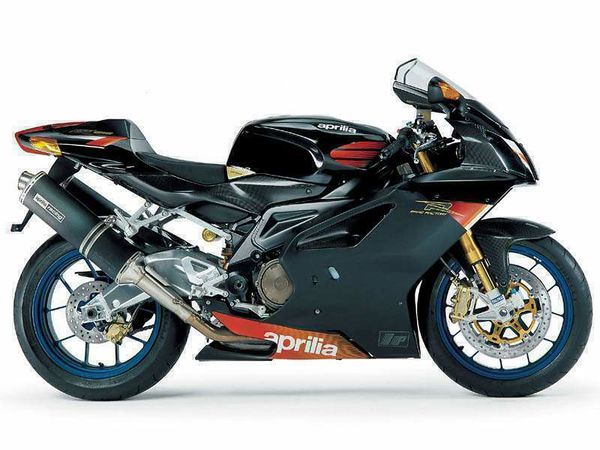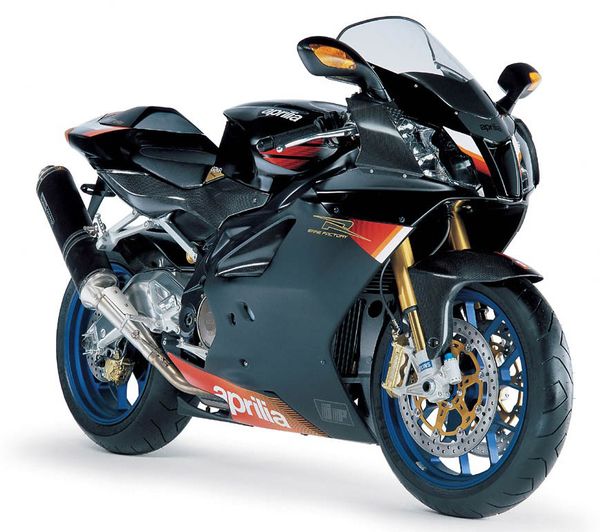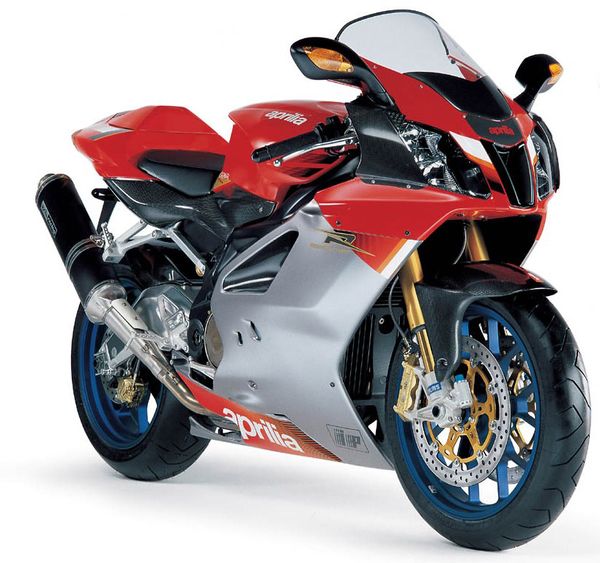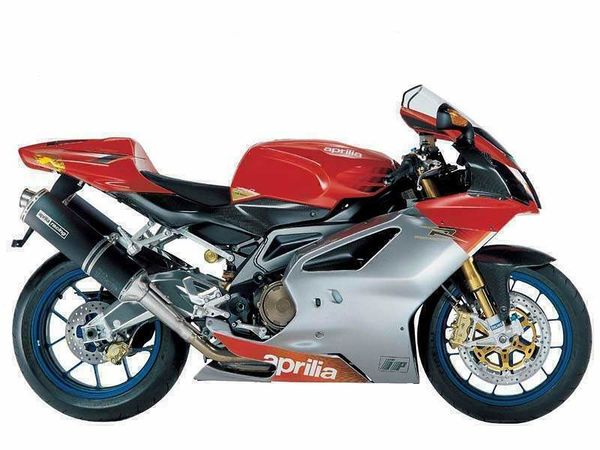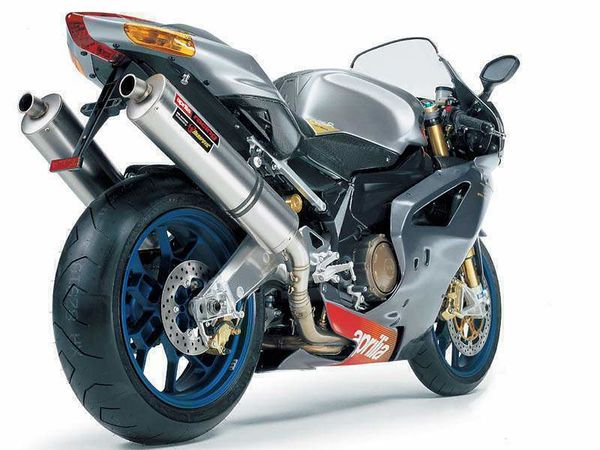Aprilia RSV1000 Mille R Factory
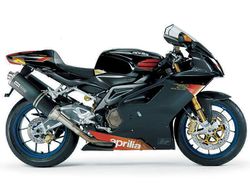 |
|
| Aprilia RSV1000 Mille R Factory | |
| Manufacturer | |
|---|---|
| Production | 2004 |
| Engine | Four stroke, longitudinal 60°V twin, DOHC, 4 valves per cylinder |
| Compression ratio | 11.8:1 |
| Top Speed | 278.0 km/h / 172.74 mph |
| Ignition | Digital electronic with one spark plugs per cylinder |
| Spark Plug | NGK, DCPR9E |
| Transmission | 6 Speed |
| Frame | Type: Box section sloping twin-spar aluminum alloy frame. Two-chamber adjustable Öhlins Racing steering damper with one-piece mounting. |
| Suspension | Front: Öhlins 43 mm diameter upside-down fork with adjustable compression rebound and preload Rear: Aluminum alloy double banana swing arm, APS progressive system linkage. Öhlins gas nytrogen hydraulic shock-absorber with adjustable rebound, compression, preload and length |
| Brakes | Front: 2 x 320 mm discs, 4 piston radial calipers, Brembo Rear: Single 220 mm disc, 2 piston radial caliper, Brembo |
| Front Tire | 120/70 ZR17 |
| Rear Tire | 190/50 ZR17 |
| Wheelbase | 1415 mm / 55.7 in |
| Seat Height | 810 mm / 31.9 in |
| Weight | 185 kg / 408 lbs (dry), |
| Fuel Capacity | 18 Liters / 4.8 US gal |
| Manuals | Service Manual |
It could reach a top speed of 278.0 km/h / 172.74 mph.
Engine[edit | edit source]
The engine was a Liquid cooled cooled Four stroke, longitudinal 60°V twin, DOHC, 4 valves per cylinder. The engine featured a 11.8:1 compression ratio.
Drive[edit | edit source]
Power was moderated via the Multiple disk in oil bath with patented PPC Claimed Horsepower: -assisted hydraulic control..
Chassis[edit | edit source]
It came with a 120/70 ZR17 front tire and a 190/50 ZR17 rear tire. Stopping was achieved via 2 x 320 mm discs, 4 piston radial calipers, Brembo in the front and a Single 220 mm disc, 2 piston radial caliper, Brembo in the rear. The front suspension was a Öhlins 43 mm diameter upside-down fork with adjustable compression rebound and preload while the rear was equipped with a Aluminum alloy double banana swing arm, APS progressive system linkage. Öhlins gas nytrogen hydraulic shock-absorber with adjustable rebound, compression, preload and length. The RSV1000 Mille R Factory was fitted with a 18 Liters / 4.8 US gal fuel tank. The bike weighed just 185 kg / 408 lbs. The wheelbase was 1415 mm / 55.7 in long.
Photos[edit | edit source]
Overview[edit | edit source]
Aprilia RSV 1000 Mille R Factory
Review
Carving through an uphill left-hand turn, with
the mountains turning shades of misty blue ahead, I felt my knee puck
grazing the smooth asphalt. The new Aprilia Factory wasnt even trying and
felt so totally in control I was initially surprised at the lean angle.
Riding the near-deserted Blue Ridge ParkWay an hour before sundown, I was completely at one with the stunning silver machine beneath me. Feeling more agile, more powerful and smaller than last years R, I was deep in Öhlins suspension paradise twisting and turning along the ParkWay. With nothing more than a few Cruisers to pass, I had the road to myself and enjoyed a fast, solo ride till the advancing shadows told me it was time to head home. I guess the first thing to do is explain a little about the 04-model designation to avoid any confusion. Last year, the R was the top of the line Mille, featuring upgraded Öhlins suspension and lighter OZ racing wheels.
This year, the Aprilia Mille R with Showa forks is going to be the base model, with the Factory as the limited edition flag ship Mille. Wearing top-shelf Öhlins suspenders and steering damper, the price differential is $8,000, with the R priced at $25,500, and the Factory at $33,500 Conflicting schedules meant I missed the original press launch of the new bikes in Las Vegas, but Aprilias Robert Pandya quickly came to the rescue a few weeks later with a phone call. If I could make it over to Charlotte, North Carolina the next day, he could let me have one for a couple of weeks. The bike had to make a television appearance on Speed Channel first and then it would be free. Twenty-four hours later, blasting up through the Pisgah National forest on my way home, I was running hard and fast with my friend Jimmy onboard a Triumph Speed Four test bike. Now Jimmy is no slouch on a motorcycle, and it takes some serious determination to hold him off on the street or track. Not so on the Factory. By the time I hit the blacktop, the Speed Four was a distant memory in my mirrors, and he certainly had some comments about the Factorys handling when we stopped for gas. Since picking up the Factory I have ridden one on the track in both Las Vegas and Florida, so between road and track I have had plenty of seat time. Having had some mixed results with worn tires, as well as the dubious honor of being the first journalist in North America to pitch one on the race track, my results here have been mixed. Both times I rode the Factory on the track, it was on fried rubber from previous journalist testing and it felt like being on a roller skate in the rain. Robert Pandya to the rescue again during my second track day: New Pirellis fixed everything, elevating the Factory to easiest and most enjoyable bike ridden on the track this year.
I am not saying there arent faster bikes; the Factory just has the best balance of power, handling and braking for my personal tastes. Four cylinder litre bikes are so brutally fast, and powerful, there is little room for error on the track, whereas the Aprilia is a lot more forgiving if you err. Sure it will spin up if you are too heavy on the gas and can hit some big speeds quick, but with its Öhlins suspension, radial brakes and race inspired frame, it never feels out of control Hidden away between the sculptured frame rails, is a new engine called the V-60 Magnesium. Replacing the tried and tested V990, it is still essentially the same longitudinal 60-degree V-twin, with 4 valves per cylinder and double overhead cams, it has just undergone some changes in the quest for the quoted 139 horsepower. Starting in the cylinder heads, Aprilia has drawn from their success on the racetrack to make the combustion chambers more efficient. Enlarging the squish area between the intake and exhaust valves, allows the new engine to require only a single spark plug. Camshafts are also new, as are the valve springs, although valve sizes remain the same.
Getting fuel into the cylinders, 57mm throttle bodies, up from last years 51mm, get new intake ducts and a single injector per cylinder. The pressurized air-box is also said to give an extra 3% increase in power once on the move. Electronics are managed by a new ECU that takes its information from 15 different sensors, before being passed through a CAN line (Controlled Area Network) to an auto diagnosis terminal located in the instrument panel. The net result of all these changes is a highly responsive engine with smooth power that unlike previous Milles, really kicks on top. On the track with high rpms and lots of full throttle applications it is about as perfect as it could be, but on the road it does have one area of weakness. Running down hill in a low gear at high rpms the bike feels as if it running lean or low on fuel, and getting back on the throttle the bike seems to hesitate a little. Keeping the bike in a higher gear, hence lower rpms, and using more throttle cures the problem, but is not always practical traveling down steep mountain roads. Riding up hill with a fuller throttle on the other hand, the power delivery is so rich, sumptuous and smooth, you will think youve died and gone to heaven, with 5,000 rpm being the magic number. At this point in the power curve the bike feels totally relaxed, the chassis and brakes as if they are out for Sunday stroll. One word of warning though, in top gear this equates to about 160kph, so keep an eye on the speedometer.
The Factory and the standard R, actually share the same basic chassis geometry as last years model. Subtle changes abound though, with the headstock repositioned to lower the bike. Further lowering has also taken place in the swing arm mounting and the swing arm pivot has been moved forward 0.5mm. The engine now sits 4mm further to the right to complete the changes, and the sum of all the parts adds up to a very different feeling bike. One of the most noticeable improvements is the way the bike turns in to fast corners. The old Mille always felt as if it wanted to run a tad wide asking for a little muscle. The Factory doesnt exhibit these tendencies and also feels a lot more nimble out on the road. It is also a lot easier to ride around town and in traffic. The whole throttle, gear-change, steering-input package just seems to work together better, making the big-twin fun where I felt the R to be work. On the track or on the street, it is all but impossible to fault the Öhlins suspension, or the four-piston radial Brembo brakes for that matter. The 43mm forks allow adjustment for spring pre-load, compression and rebound damping, and only on the track did we dial in more pre-load and slow down the rebound damping a little, as the stock settings were perfect for road work. Stiction is kept to a minimum with the fork legs coming titanium nitride coated, and there is total of 120mm of travel available. Keeping the rear wheel from misbehaving, the Öhlins shock out back gets adjusted the same way, and has a piggyback nitrogen cylinder built into the body. I had no reason to touch the steering damper, as no matter now hard I got on the throttle I never experienced any headshake. First seen on an Aprilia 250GP bike, radial brakes are becoming more common these days and once you have used them you wont want to go back. Providing incredible feedback at the lever with eyeball popping stopping power at the pads, the Brembo-sourced items are absolutely first-class. Using four individual pistons pushing their own brake pads, the radial caliper doesnt experience any flex, therefore the pads stay more in line with the 320mm discs for better braking and extended life.
The adjustable lever is light to the touch, with enough travel for trail braking before the pads really start to bite down. Using them to out brake other bikes into corners felt a little like cheating, it was possible to leave it so late, and on the street they just added to the overall confidence the Aprilia exudes Dry weight is quoted for the Aprilia Factory as 185kg and this is no doubt helped by the liberal use of carbon fibre. No complaints here as the bike if visually stunning, once I got past the funky looking front air intake. Items listed are: front and rear mudguards, faring extractors, windscreen deflectors, upper fairing cover, and fairing side panels. The wheels are also a source of weight saving with a claim that says they are 25% lighter than the lightest wheels on the market. Aprilia even went as far as to anodize them instead of painting to save weight. An interesting point to note is the front wheel has six spokes, the rear five. This is being claimed as being a structural issue. I wonder if someone in Italy spaced out and forgot to count them? As well as being light, the Factory is extremely narrow and this is helped by the use of the integrated turn signals in the mirrors up front and as part of the sleek, sexy looking tail unit out back. The mirrors themselves, in the Italian style of whats behind doesnt count, are truly useless, giving wonderful views of your arms, with a bit of rear facing action thrown in around the edges.
The tail light gets its own award for being the coolest looking taillight to be used on a motorcycle, as does maybe the whole rear tail section. Up the other end, I found the cockpit area a little ugly, although the digital speedo/conventional tachometer unit is tidy enough. Shift light comes on at 10,200rpm with red line hitting at 12,000rpm; so there is some useful over rev. Warning lights are small, and all where they should be. The usual funky Aprilia upside down horn and turn signal switches will provide some fun, as you honk to change directions and flash to warn on-coming motorists for a couple of days. There is also a lap counter you can play with during track days, but unfortunately I didnt get to try it. Fast, expensive and exotic, the Aprilia Mille Factory is a motorcycle for the serious Italian sport-bike aficionado. Beautiful to behold, and even more beautiful to ride, there are only going to be a limited number coming to this country, so ownership is going to be the ticket to a very exclusive club. Source MCNews.au
| Make Model | Aprilia RSV 1000 Mille R Factory |
|---|---|
| Year | 2004 |
| Engine Type | Four stroke, longitudinal 60°V twin, DOHC, 4 valves per cylinder |
| Displacement | 997.6 cc / 60.9 cu-in |
| Bore X Stroke | 97 x 67.5mm |
| Cooling System | Liquid cooled |
| Compression | 11.8:1 |
| Lubrication | Dry sump with separate oil tank |
| Induction | Integrated electronic engine management system. Indirect multipoint electronic injection. Throttle body diameter 57mm. |
| Ignition | Digital electronic with one spark plugs per cylinder |
| Spark Plug | NGK, DCPR9E |
| Starting | Electric |
| Max Power | 102 kW / 139 hp @ 9500 rpm |
| Max Torque | 107 Nm / 10.9 kgf-m / 78.9 lb-ft @ 7500 rpm |
| Clutch | Multiple disk in oil bath with patented PPC Claimed Horsepower: -assisted hydraulic control. |
| Transmission | 6 Speed |
| Final Drive | Chain, 40/16 (2.5) |
| Primary Drive Ratio | 60/31 (1.935) |
| Gear Ratio | 1st 34/15 (2.27), 2nd 31/19 (1.63), 3th 26/20 (1.3), 4th 24/22 (1.091), 5th 24/25 (0.96), 6th 23/26 (0.88) |
| Frame | Type: Box section sloping twin-spar aluminum alloy frame. Two-chamber adjustable Öhlins Racing steering damper with one-piece mounting. |
| Front Suspension | Öhlins 43 mm diameter upside-down fork with adjustable compression rebound and preload |
| Front Wheel Travel | 120 mm / 4.7 in |
| Rear Suspension | Aluminum alloy double banana swing arm, APS progressive system linkage. Öhlins gas nytrogen hydraulic shock-absorber with adjustable rebound, compression, preload and length |
| Rear Wheel Travel | 133 mm / 5.2 in |
| Front Brakes | 2 x 320 mm discs, 4 piston radial calipers, Brembo |
| Rear Brakes | Single 220 mm disc, 2 piston radial caliper, Brembo |
| Wheels | Light forged aluminum wheels |
| Front Tire | 120/70 ZR17 |
| Rear Tire | 190/50 ZR17 |
| Rake | 24.8° |
| Trail | 101.7 mm / 4.0 in |
| Dimensions | Length 2035 mm / 80.1 in Width 730 mm / 28.7 in Height 1130 mm / 44.5 in |
| Wheelbase | 1415 mm / 55.7 in |
| Seat Height | 810 mm / 31.9 in |
| Dry Weight | 185 kg / 408 lbs |
| Fuel Capacity | 18 Liters / 4.8 US gal |
| Reserve | 4 Liters / 1.1 US gal |
| Standing ¼ Mile | 10.7 sec |
| Acceleration 60-140 Km/h | 10.2 sec |
| Top Speed | 278.0 km/h / 172.74 mph |
